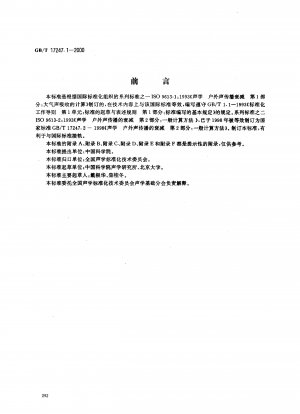GB/T 17247.1-2000
Acoustics-Attenuation of sound during propagation outdoors-Part 1: Calculation of the absorption of sound by the atmosphere (English Version)
- Standard No.
- GB/T 17247.1-2000
- Language
- Chinese, Available in English version
- Release Date
- 2000
- Published By
- General Administration of Quality Supervision, Inspection and Quarantine of the People‘s Republic of China
- Latest
- GB/T 17247.1-2000
- Scope
- This standard specifies the calculation method of the sound attenuation caused by atmospheric absorption when the sound emitted by the outdoor sound source passes through the atmosphere under various meteorological conditions. For pure tones, atmospheric absorption attenuation is expressed by an attenuation coefficient related to four variables, namely sound frequency, atmospheric temperature, humidity, and air pressure. The calculated attenuation coefficients are listed in a table. The air pressure in the table is one standard atmospheric pressure (101.325 kPa), and the ranges of the other three variables are often encountered in the prediction of outdoor sound propagation, which are: ——frequency, 50~10 kHz; ——temperature, -20~+50℃; One—relative humidity, 10% to 100%. Equations are also presented for a wider range of variables for special purposes, for example, ultrasonic frequencies in scale model studies, and low air pressure when sound travels from heights to the ground. For broadband sound, a fractional octave band-pass filter (such as a 1/3-band band-pass filter) is commonly used for analysis. This standard stipulates that the atmospheric absorption attenuation is calculated using the method of pure tone whose frequency is the center frequency of the frequency band. In addition, an alternative spectral integration method is described in Appendix D. The sound spectrum may be broadband without obvious discrete frequency components, or it may be a composite of broadband sound and discrete frequency sound. This standard is applicable to the atmosphere with uniform meteorological conditions, and can also be used to determine the correction amount of the sound pressure level measured taking into account the difference between atmospheric absorption losses under different meteorological conditions. This standard may be extended to inhomogeneous atmospheres, especially atmospheres in which meteorological conditions vary with altitude, as discussed in Appendix C. This standard only considers the main absorption mechanisms in atmospheres in which there is no significant fogging or pollution. Mechanisms other than atmospheric absorption, such as the calculation of sound attenuation caused by refraction or ground reflection, are described in GB/T 17247.2-1998.
GB/T 17247.1-2000 history
- 2000 GB/T 17247.1-2000 Acoustics-Attenuation of sound during propagation outdoors-Part 1: Calculation of the absorption of sound by the atmosphere
